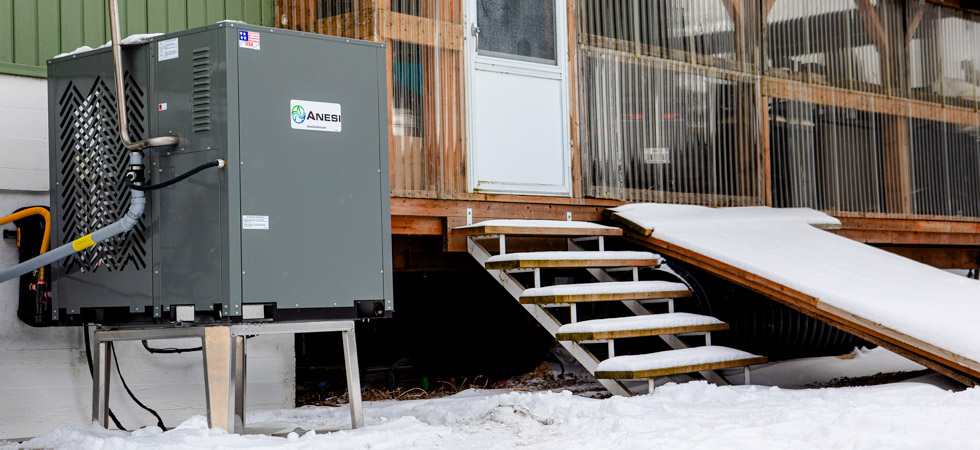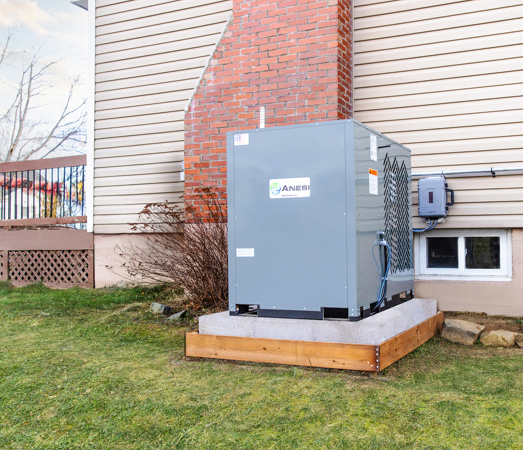
A gas absorption heat pump (GAHP) runs on a heat source — usually natural gas or propane — rather than electricity. GAHP technology also allows additional energy to be absorbed from outside air, maximizing energy efficiency — a prime example of propane's role in heat pumps and how it can play an important role in systems that are environmentally friendly.
To learn more about this technology, the current GAHP and heat pump market, and propane’s role in heat pump systems, BPN reached out to Bill Hewa, product manager at Stone Mountain Technologies.
Can you describe how GAHPs work, including the Anesi GAHP?
The Anesi GAHP … meets the definition of a ‘heat pump’ because it both generates heat and transfers heat. The Anesi GAHP is installed outside of the home, where it is connected to the propane fuel source. The heat generated from combustion is combined, through an ammonia-water thermodynamic cycle, with heat absorbed from the outdoor air and transferred into the building via a hydronic fluid. This heated hydronic fluid, consisting of water and food-grade glycol solution, is circulated through the custom air handling unit (AHU) installed inside the building. In a forced-air space heating scenario, air is heated from the incoming solution and blown through the building’s ductwork. If the heating system includes domestic hot water, the incoming heated solution is also routed through a heat exchanger within an indirect storage tank, heating the building’s water. Alternate system configurations are available to accommodate hydronic heating scenarios as well as existing air conditioning coils. The highlight of the GAHP story is that fuel usage efficiencies exceeding 100% are achieved due to the unique thermodynamic cycle, which allows heat from ambient air to be absorbed and combined with the generated heat, even at temperatures as low as -15 F. GAHPs can operate at temperatures lower than -15 F, even down to -40 F, but at those temperatures, the available heat in the ambient air is negligible.
Can you describe some of the technologies available in Stone Mountain heat pumps? Are there any newer innovations that Stone Mountain has implemented in recent months or years?
The Anesi GAHP’s thermodynamic cycle, which uses the ammonia refrigerant and water, works like the mechanical compressor on traditional electric heat pumps. The energy generated from this cycle also significantly reduces the electrical draw of the GAHP. The Modbus communication protocol provides reliable monitoring and control of all equipment through data exchange between sensors and logic controllers. A cellular network connection allows operational data to be shared with the factory customer service team and also enables software download in the opposite direction. Factory-installed hydronic components within the custom turnkey AHU include a hydronic pump, three-way valve, glycol expansion tank and glycol reserve tank, resulting in reduced installation time. A multispeed ECM blower quietly delivers warm air throughout the building, even during the coldest outside temperatures. Efficiency and comfort are prioritized within the technical algorithm loaded into the control board, which drives the performance of the AHU system. The design minimizes moving parts to ensure reliable, long-term operation. A companion progressive web app (PWA) is available for end users and HVAC professionals to monitor installed systems.
What does the process of innovation look like for the Stone Mountain team? How does your team remain open to new opportunities?
There are several key ways that Stone Mountain Technologies stays ahead of innovation and new opportunities. First, we maintain close connections with independent research firms, such as the Natural Gas Innovation Fund, and work directly with gas providers who drive and benefit from technology improvements. A secondary tactic is working closely with our contractor base, from the perspective of continuously training contractors, but also requesting their feedback on technology and trends. We also actively solicit feedback from contractors to constantly improve our products.
How Does the current market for residential heating compare to the market for commercial Heating?
 The residential heating market, particularly for gas products, focuses on the cost benefits that gas offers over electricity, while also resisting regulatory pressure toward electrification. Electrification can be an expensive proposition for a solution that fails to maintain the same comfort that homeowners have been accustomed to. Commercial markets are concerned with cutting operating costs, [which can be accomplished with] efficiency levels offered by GAHP solutions. Payback is an integral part of the cost savings and capex for equipment equation.
The residential heating market, particularly for gas products, focuses on the cost benefits that gas offers over electricity, while also resisting regulatory pressure toward electrification. Electrification can be an expensive proposition for a solution that fails to maintain the same comfort that homeowners have been accustomed to. Commercial markets are concerned with cutting operating costs, [which can be accomplished with] efficiency levels offered by GAHP solutions. Payback is an integral part of the cost savings and capex for equipment equation.
Compared to electricity or natural gas, are there any advantages (or disadvantages) to incorporating propane in heat pump technology?
Propane heating can offer consistent and comfortable heating at a lower operating cost, with no need for backup, when compared to electric solutions. The one disadvantage is the lingering perception that propane, as a fossil fuel, is environmentally unfriendly. This perception is, of course, blatantly incorrect (and currently being ‘corrected’ by some governmental agencies), and [GAHP solutions] offer an opportunity to address consumers and regulators who don’t see the potential in a clean, cost-effective and comfortable solution for home and business heating needs.
What should propane providers & distributors know about The current State of the heat pump market?
Offering gas absorption heat pump technology to current heating oil customers provides them a chance to improve their efficiency and reduce operating costs significantly; at the same time, this change enables gas providers to hold their customer base and mitigate losses to electrification.
What are some of the technological trends either in place now or on the horizon that Stone Mountain is keeping an eye on going forward?
Stone Mountain Technologies’ ... near-term plan is to educate the market regarding our technology to increase adoption, as well as to expand the product line to cover different capacities and application types. As fuel research and development continue to increase the amount of renewable natural gas available, as well as begin offering H2 as a prospective fuel, Stone Mountain Technologies will stay abreast of research and testing so our products can operate with the next generation of fuels. We continue to monitor developments in cold climate heat pumps to ensure we offer a solution from the perspective of comfort, cost efficiency and reliability.


